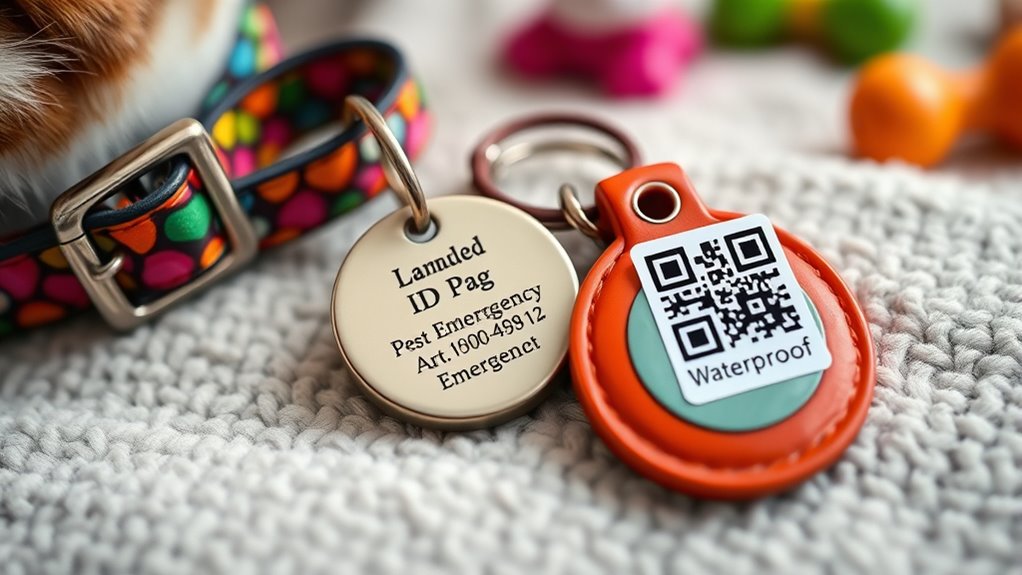To create an effective pet emergency contact and ID system, start by keeping a list of local vets and emergency clinics, with your regular vet’s contact easily accessible. Attach a durable ID tag with your current phone number and consider microchipping your pet to provide a permanent ID. Regularly update all contact information and guarantee everyone nearby knows how to access it when needed. Continue exploring for expert tips to build a thorough safety plan.
Key Takeaways
- Create a comprehensive list of local veterinary clinics, emergency animal hospitals, and trusted backup contacts, and keep it accessible.
- Attach durable, updatable ID tags with current owner contact info and ensure microchip registration details are accurate and recent.
- Regularly verify and update microchip registration and ID tag information to maintain reliable pet identification.
- Store emergency contact information in visible, easily accessible locations around your home and pet’s resting area.
- Educate all caregivers on how to access and use the pet’s ID tags and microchip information during emergencies.

Having a reliable pet emergency contact and ID system is essential for guaranteeing your pet’s safety if they get lost or injured. When emergencies happen, quick access to veterinary contacts can make all the difference. Keep a list of local veterinary clinics, emergency animal hospitals, and your regular vet’s phone number in a visible spot, like your phone or near your pet’s usual resting area. This way, if your pet needs urgent care, you can reach professionals immediately. It’s also wise to have a backup contact, such as a trusted neighbor or pet sitter, who can make decisions on your behalf if you’re unavailable. This ensures that someone with your pet’s medical history and needs can act swiftly.
Another critical aspect is pet microchipping. Microchipping your pet provides a permanent form of identification that can’t be lost or easily removed. When a lost pet is found, animal shelters and veterinary clinics can scan the microchip to retrieve your contact details, helping reunite you with your furry friend quickly. Make sure your microchip registration is always up to date with current contact information, including your phone number and address. Never rely solely on a collar tag, as tags can fall off or be obscured, but a microchip offers peace of mind knowing that, even if your pet’s collar is missing, they still have a way to be identified. Additionally, Vetted options for portable pet ID tags are available that are durable and easy to update with your current contact info.
In addition to microchipping and keeping veterinary contacts handy, consider having a well-prepared ID tag attached to your pet’s collar. Your pet’s ID tag should include your current phone number, your name, and possibly your address. This simple step can often lead to a quick recovery if your pet strays. Combine this with microchipping for the most effective identification system. Remember, the key is to keep all information current and easily accessible. Check your pet’s microchip registration periodically and update your vet contact details whenever you move or change vets.
Frequently Asked Questions
What Materials Are Best for Durable Pet ID Tags?
You should choose durable pet ID tags made from metal alloys like stainless steel or titanium, which resist rust and damage. These materials are tough and long-lasting, ensuring your pet’s information stays intact. Look for engraving options that are deep and clear, so your contact details remain legible over time. These metals and features combine to create a sturdy, reliable ID tag that withstands daily wear and tear.
How Often Should I Update My Pet’s Emergency Contact Info?
To keep your pet’s safety super secure, update their emergency contact info at least every six months. Regular revisions guarantee that rescue responders get current, correct details. Incorporate essential emergency preparedness pet safety tips by verifying your pet’s ID tags and microchip info regularly. Consistent updates prevent potential problems and promote peace of mind, making sure your pet remains protected and prepared for any emergency.
Can I Include Multiple Emergency Contacts on One ID Tag?
Yes, you can include multiple contacts on one ID tag to guarantee emergency redundancy. Adding several emergency contacts increases the chances someone can reach a loved one quickly if your pet gets lost or injured. Use a tag with space for multiple phone numbers or opt for a tag with a QR code linking to a detailed contact list. This way, you maximize your pet’s safety with multiple contacts readily accessible.
What’s the Best Way to Ensure My Pet’s Microchip Info Is Current?
Did you know that over 50% of microchips aren’t registered or updated? To keep your pet’s microchip info current, regularly check your registration details and update them immediately if you move or change contact info. Make sure your pet ID privacy is maintained by only sharing essential info. This guarantees your pet can be quickly identified and returned if they get lost, giving you peace of mind.
Are There Any Legal Requirements for Pet ID Systems?
You need to guarantee your pet’s ID system complies with local laws, which often include legal compliance and registration requirements. Check your city or state regulations, as some areas mandate microchipping or specific ID tags for pets. Staying updated on these rules helps you avoid fines and ensures your pet’s safety. Regularly verify that your pet’s information is current and properly registered to meet all legal obligations.
Conclusion
Creating a pet emergency contact and ID system is like building a safety net woven with care and clarity. It guarantees your furry friend’s well-being is always protected, no matter the situation. By taking these simple steps, you’re stitching together peace of mind for yourself and a lifeline for your pet. Remember, in emergencies, a well-prepared system acts as a guiding star, leading your pet back home safely.










